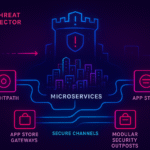When your website is your business and every second counts, performance issues can cost you real money. That’s where load balancers come in—keeping things running smoothly behind the scenes. And no, we won’t make this boring.
Load Balancing: Like a Nightclub Bouncer for the Internet
Imagine running the hottest club in town on a Saturday night. Hundreds of people rush to one entrance—chaos, delays, and unhappy guests. Now picture a crew of skilled bouncers guiding people to multiple doors, keeping things organized and safe.
That’s what a load balancer does for your website and apps—ensuring every visitor gets in smoothly, no system gets overwhelmed, and everything stays stable.
What a Load Balancer Really Does (No Geek Speak)
At its core, a load balancer spreads incoming website or app traffic across several servers so that no single one gets overloaded.
According to recent industry reports, businesses experience about 10–20 hours of downtime annually, which can result in major financial losses. Load balancers help reduce that risk significantly.
But they do more than just traffic control:
-
Monitor systems: They check if servers are responding properly and remove any that aren’t.
-
Route traffic smartly: They send users to the most responsive, available servers.
-
Boost security posture: Many also help guard against suspicious traffic behaviors.
-
Handle encrypted sessions: They manage secure connections efficiently, taking pressure off your core systems.
Why Load Balancing Matters to Your Business
Statista’s 2024 report says 1 in 4 users will leave a site if it loads in more than 3 seconds. In today’s world, speed and reliability are non-negotiable.
Here’s what load balancers offer:
-
Better uptime: They keep your site live even if one server fails.
-
Scalability: As your traffic grows, you can add more servers easily.
-
Improved performance: Load is spread out, so everything runs faster.
Picking the Right Load Balancer: A Quick Guide
Not all load balancers are the same. Here are your main options:
Hardware vs. Software
-
Hardware solutions are high-performance physical devices, often used in industries that demand extreme reliability.
-
Software-based versions are flexible, cost-effective, and ideal for cloud or virtual environments. These are growing rapidly in popularity.
Layer 4 vs. Layer 7
-
Layer 4 works on basic network info (like IP and port). Fast and simple.
-
Layer 7 digs deeper, handling web content rules and traffic logic. It’s more advanced and great for dynamic applications.
Reports suggest that around 65% of businesses now prefer Layer 7 solutions for their smarter routing abilities.
Real-Life Success Stories
Black Friday E-Commerce Surge
One client saw a 1,200% spike in traffic during Black Friday 2023. Thanks to load balancing, their site remained fast and responsive, leading to a 43% increase in sales.
Smoother Financial Transactions
A finance company had issues with timeouts during high usage. By fine-tuning traffic flow and maintaining user continuity, they reduced errors by 78% and boosted successful transactions by 31%.
Popular Load Balancing Methods
Here’s how load balancers decide where to send users:
-
Round Robin: Distributes users evenly, one at a time.
-
Least Connections: Sends users to the server handling the fewest sessions.
-
IP Hash: Keeps users consistently connected to the same server.
-
Weighted Options: Routes more traffic to more capable servers.
-
Resource-Aware Routing: Makes decisions based on system performance metrics.
Internal reports show that while Round Robin is still common, smarter, performance-based strategies are on the rise.
The Evolution: From Load Balancer to Full Application Manager
Today’s load balancers do much more than split traffic. They’re often part of broader tools called Application Delivery Controllers (ADCs), which include:
-
Integrated traffic management
-
Secure data handling features
-
Response optimization (like caching and compression)
-
Region-based server support for global use
In fact, a 2024 tech report noted that over 70% of large companies now consider them essential for both performance and reliability.
Setting Up a Load Balancer: It’s Simpler Than You Think
Here’s a quick-start checklist:
-
Define your needs (speed, security, or both)
-
Choose a solution (cloud, virtual, or physical)
-
Pick your servers
-
Set up system checks
-
Choose your routing strategy
-
Test and fine-tune
Major platforms like AWS, Azure, and Google Cloud make this process easy with built-in tools. Companies like Edgenexus also offer tailored solutions with advanced features.
What’s Next in Load Balancing?
The space is evolving fast. Here are some trends to watch:
-
AI-based optimization: Predictive traffic control for smoother performance
-
Edge integration: Bringing content delivery closer to the user
-
Zero-trust friendly: Helping build secure, access-controlled environments
-
Container-native options: Built for modern microservices
-
Self-managing tools: Systems that adjust automatically with minimal input
Forecasts suggest that by 2026, most enterprise applications will use some form of smart traffic control driven by intelligent systems.
How Edgenexus Approaches Load Balancing
At Edgenexus, we aim to make load balancing both powerful and simple. Here’s what sets us apart:
-
Easy-to-use interface: No complex training required
-
Flexible deployment: Choose between cloud, on-prem, or hybrid
-
Built-in protection: Safeguards your apps from common issues
-
Predictable costs: No hidden surprises
-
Expert support: Help from real people, not just manuals
Is It Time to Add a Load Balancer?
You probably need one if:
-
Your website or app can’t afford downtime
-
You see spikes in traffic throughout the day or year
-
You want to do server maintenance without taking systems offline
-
You have users across different regions
-
You’re using modern tools like containers or hybrid clouds
-
You care about both performance and resilience
Final Thoughts: Load Balancing Is No Longer Optional
In a fast-moving digital world, reliable app delivery isn’t just a nice-to-have—it’s a must. Whether you’re running an e-commerce store, a global SaaS platform, or a secure internal portal, a load balancer ensures your users get a fast, smooth, and consistent experience.
It’s not just about traffic control—it’s about future-proofing your business. Now’s the time to invest.









